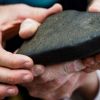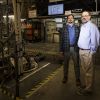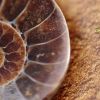-
 +15 +8
+15 +8The Argument We Need for the Universal Wearing of Beards
From a Victorian essay: The Beard, combining beauty with utility, was intended to impart manly grace and free finish to the male face.
-
 +2 +1
+2 +1Here's How We're Recreating Alien Atmospheres on Earth To Search for Life Beyond the Solar System
Over the last 30 years, scientists have discovered thousands of new planets. But one of the big questions that remains—especially for those hunting for alien life—is whether those planets and their atmospheres could support life. Ground- and space-based telescopes can tell us the basics of each planet's specific cocktail of gasses that form its atmosphere, but to get a closer look, scientists are using sophisticated tools to simulate faraway planets in their earthbound labs.
-
 +12 +2
+12 +2After Bloodbath, The National Zoo's Naked Mole-Rats Finally Choose Their Queen
At last, we’ve reached the conclusion of this scintillating drama: the National Zoo’s naked mole-rat colony has chosen its queen. In case you’ve been living under a rock, let us catch you up: the Small Mammal House at the Smithsonian National Zoo is home to a colony of naked mole-rats, and for the last several months they’ve been engaged in a quiet—but brutal—battle for political supremacy. Naked mole-rats are one of just two eusocial mammalian species, which means they live much like colonies of bees or ants...
-
 +3 +1
+3 +1Crashes increase when speed limits dip far below engineering recommendation
Speed limits set only five miles per hour below engineering recommendations produce a statistically significant decrease in total, fatal and injury crashes, and property-damage-only crashes, according to a group of Penn State researchers. "If (however) you lower the speed limit by 10, 15, 25 miles per hour, or more, drivers stop paying attention," said Vikash Gayah, assistant professor of civil engineering. "We found there was an increase in fatal and injury crashes at locations with posted speed limits set 10 miles per hour or more below engineering recommendations."
-
 +19 +4
+19 +4Helium exoplanet inflated like a balloon, research shows
An international team of researchers, including Jessica Spake and Dr David Sing from the University of Exeter, have detected the inert gas escaping from the atmosphere of the exoplanet HAT-P-11b – found 124 light years from Earth and in the Cygnus constellation.
-
 +3 +1
+3 +1Madagascar Meteorite Came from the Early Solar System, Experts Find
This past summer, people in Madagascar saw an ancient 4.5 billion-year-old meteor from the early solar system come crashing down.
-
 +18 +2
+18 +2Inside Colombia’s beloved candy factory.
For nearly 50 years, Bon Bon Bums have been produced in the Colombina factory in La Paila, north of Cali. At the start, 20 workers were responsible for the production of four million lollipops per month. Today, in that same factory, 200 workers produce more than 40 times as many.
-
 +15 +4
+15 +4The most reliable scientific model to date for detecting when a person is lying, based on thermography
Researchers from the University of Granada (UGR) have designed the most accurate laboratory model to date for determining if a person is lying or telling the truth. This method, which uses thermography techniques, is based on the so‑called ‘Pinocchio Effect’: when a person is lying, the temperature of the nose decreases while that of the forehead increases, among other facial thermal changes.
-
 +15 +2
+15 +2An anonymous 4chan post could help solve a 25-year-old math mystery
A 4chan poster may have solved part of a very tricky math problem that mathematicians have been working on for at least 25 years. The user was just trying to figure out the most efficient way to watch episodes of a nonlinear anime series, but the result has generated considerable interest from mathematicians around the world who have no way to identify the anonymous user.
-
 +21 +4
+21 +4Naked Labs' 3-D Body Scanner Shows You the Naked Truth
A ate a big breakfast. So if my scans are off, don’t sweat it, I tell myself. And this was immediately following a long, unhealthy weekend (a friend’s wedding). All of the excuses of the first world were available to me as I walked up the stairs in The Assembly, a women’s club in San Francisco, one that looks like it was once a place of worship but now hosts accomplished-looking laptop-clackers and has bottles of sweet-smelling face mist in the bathroom. This is where I would get my body shape and fat percentage measured by a company that has named itself Naked.
-
 +18 +2
+18 +2A New Method For Having Lucid Dreams Has Been Discovered by Scientists
They're incredible. Amazing. Magical. But perhaps the most fantastic thing about lucid dreams – in which the dreamer becomes aware they're dreaming – is how realistic they seem.
-
 +27 +6
+27 +616 Going on 66: Will You Be the Same Person 50 years from Now?
How much do you change between high school and retirement? The answer depends on whether you’re comparing yourself to others or to your younger self. The results of a new study, the first to test how personality might change over 50 years and relying on the same data source at both time points, finds that broad patterns of thoughts, feelings and behaviors – personality – do change, and this change appears to accumulate with time. But don’t compare yourself to others; those who are the most emotionally stable when young are probably going to continue being the most stable as they age.
-
 +8 +2
+8 +2After 30 years of R&D, breakthrough announced in dark matter detection technology, definitive search to begin for axion particles
Forty years ago, scientists theorized a new kind of low-mass particle that could solve one of the enduring mysteries of nature: what dark matter is made of. Now a new chapter in the search for that particle has begun. This week, the Axion Dark Matter Experiment (ADMX) unveiled a new result, published in the journal Physical Review Letters, that places it in a category of one: it is the world’s first and only experiment to have achieved the necessary sensitivity...
-
 +20 +6
+20 +6How do horses read human emotional cues?
Scientists demonstrated for the first time that horses integrate human facial expressions and voice tones to perceive human emotion, regardless of whether the person is familiar or not. Recent studies showed the herd-forming animal possesses high communication capabilities, and can read the emotions of their peers through facial expressions and contact calls, or whinnies. Horses have long been used as a working animal and also as a companion animal in sports and leisure, establishing close relationships with humans just like dogs do with people.
-
 +11 +3
+11 +3Giant sloth vs. ancient man: fossil footprints track prehistoric hunt
Scientists have uncovered evidence of ancient humans engaged in a deadly face-off with a giant sloth, showing for the first time how our ancestors might have tackled such a formidable prey. Standing over 2 meters tall, with forelegs tipped with claws, giant sloths lived until around 11,000 years ago. Most scientists believe over-hunting by humans eventually led to their extinction.
-
 +16 +3
+16 +3How Do You Make or Maintain Friends? Put in the Time.
Friendship takes time to develop. The more time two people spend together, the more likely they are to be friends. On the other hand, there are people we see regularly but don’t consider friends. So just how many hours of togetherness does it take for an acquaintance to become a friend? Or for a friend rise to the level of best friend? And does it matter what you spend all that time doing? For the first time, there are answers: 50 hours, more than 200 hours, and yes, it does matter.
-
 +2 +1
+2 +1It’s official: Termites are just cockroaches with a fancy social life
Termites are the new cockroach. Literally. The Entomological Society of America is updating its master list of insect names to reflect decades of genetic and other evidence that termites belong in the cockroach order, called Blattodea.
-
 +11 +2
+11 +2Women Survive Crises Better Than Men
Women today tend to live longer than men almost everywhere worldwide -- in some countries by more than a decade. Now, three centuries of historical records show that women don’t just outlive men in normal times: They’re more likely to survive even in the worst of circumstances, such as famines and epidemics, researchers report.
-
 +17 +4
+17 +4Secret Link Uncovered Between Pure Math and Physics
Mathematics is full of weird number systems that most people have never heard of and would have trouble even conceptualizing. But rational numbers are familiar. They’re the counting numbers and the fractions—all the numbers you’ve known since elementary school. But in mathematics, the simplest things are often the hardest to understand. They’re simple like a sheer wall, without crannies or ledges or obvious properties you can grab ahold of.
-
 +18 +4
+18 +4A Scientist Discovers 2,000-Million-Years-Old Prokaryotic Microfossils in India
A geologist has discovered a 2,000-million-year-old “prokaryotic” microfossils in India. The microfossils were found in a carbonaneous shale from the Gawlior basin of the Bundelkhand region in Central India. Naresh Ghose, formerly geology professor at Patna University, lives in the city of Bengaluru. His latest finding was reported at the recent annual convention of the Indian Geological Congress in Nagpur.
Submit a link
Start a discussion




















